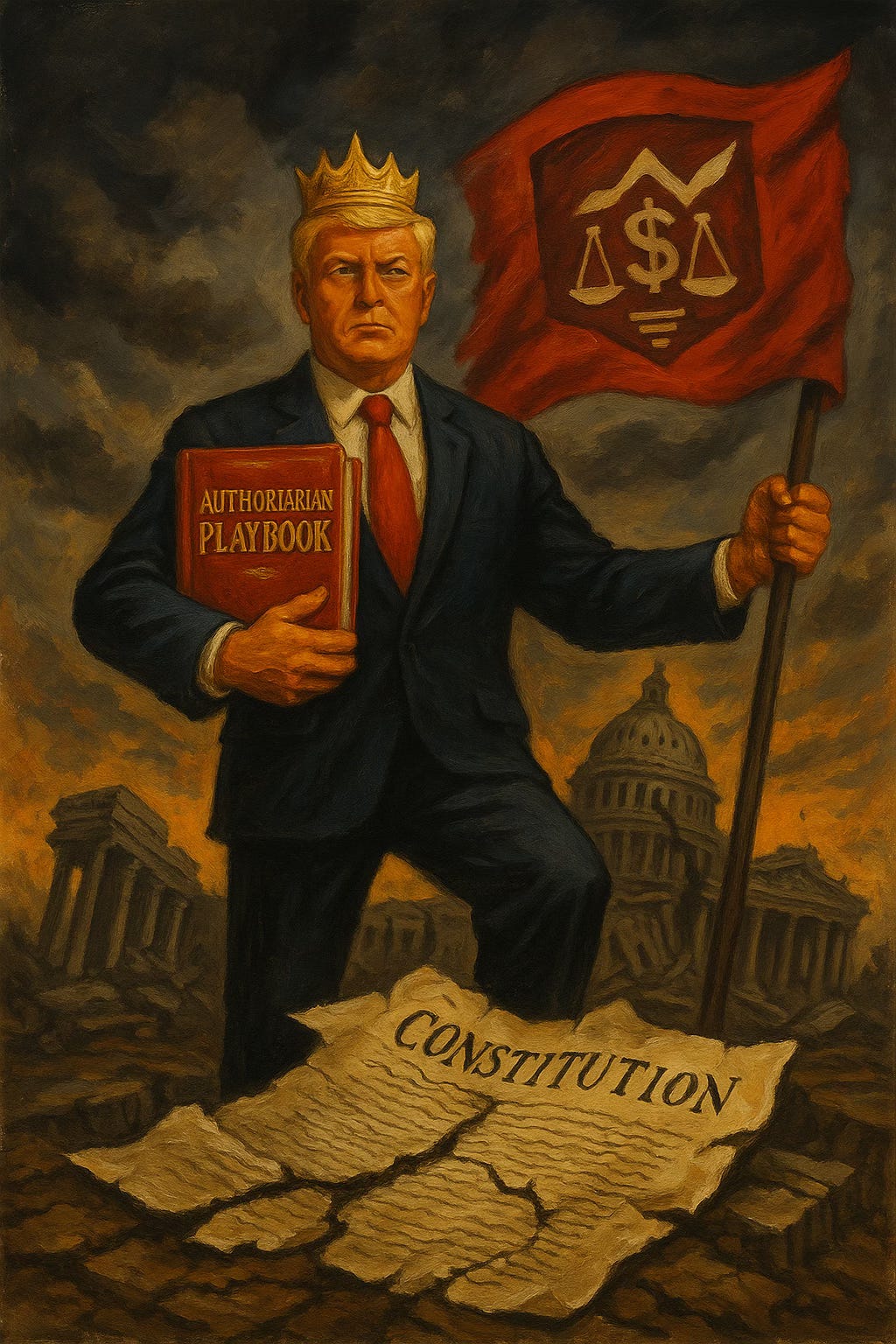The Constitution Doesn't Live Here Anymore
This is not a rehearsal. The authoritarian playbook is being implemented in real time.
Executive Overreach in Real Time
How Trump’s immigrant crackdown, military posturing, and base renaming are not isolated stunts—but a unified power grab tied to Project 2025.
1. Targeting Immigrants to Justify Power
Trump’s renewed assault on immigrants isn’t just about policy—it’s the cornerstone of a narrative that justifies authoritarian rule. By painting
migrants as an “invasion” and linking their presence to urban unrest, he unites his far-right base with more moderate voters under the banner of “order.”
At a recent rally at Fort Bragg, he declared:
“Generations of Army heroes did not shed their blood on distant shores only to watch our country be destroyed by invasion and third-world lawlessness.” 1
Shortly after, Trump announced the deployment of over 4,000 National Guard and 700 Marines to Los Angeles, calling it a mission to “liberate” the city from “rioters bearing foreign flags.” The targets were not foreign terrorists or militias—they were largely peaceful immigrant-rights protestors in a Democrat-led city. 2.
2. Restoring Confederate Base Names
Trump has resurrected one of the most symbolically loaded battles in American memory—the naming of U.S. military bases. In 2020, rare bipartisan consensus led to renaming installations that honored Confederate generals - an acknowledgement that we should not glorify a rebellion fought to preserve slavery.
But under Trump’s second term, this reversal is no accident. It is part of a much broader ideological campaign, fueled by white grievance, Christian Nationalism and the authoritarian ambitions outlined in Project 2025.
(Read my Substack: “Project 2025: A Manual for the Unmaking of American Democrac”)
This past weekend, standing before a cheering crowd at the re-renamed Fort Bragg, Trump said:
“We won a lot of battles out of those forts. It’s no time to change. And I’m superstitious, you know? I like to keep it going.” 3
We?
That ‘we” wasn’t careless, and trump wasn’t just reminiscing. He was using it to rope in his audience - and by extension, the public - into identifying with the pro-slavery Confederacy, as if its cause and values still define who we are. This isn’t nostalgia. It is a rhetorical trap that rewrites history, blending white supremacist mythology with patriotic pride. That “we” invites Americans to align, not with the Union or democratic ideals, but with the legacy of rebellion, racial hierarchy, and military. domination.
What sounds like superstition is strategy. Trump knows the power of propaganda. These name reversals are not about honoring troops. They are a cultural rebranding of the military as a tool of authoritarian control, not national defense.
They signal:
Loyalty to a whitewashed, authoritarian past
Rejection of racial reckoning and historical truth
A declaration that the military is his to reshape—not the nation’s to debate
3. Undermining Civilian Leadership to Cement His Own
Trump’s authoritarian playbook isn’t just about troop deployments or symbolic gestures — it’s also about redefining the chain of command and discrediting anyone he considers a political enemy. At Fort Bragg, he didn’t address the troops as Commander-in-Chief of a united republic. He positioned himself as a wartime leader under siege, and used the military stage to openly attack his political rivals - a chilling authoritarian tactic.
Standing before uniformed service members, Trump trashed President Biden, calling him “the architect of chaos.” He mocked Governor Gavin Newsom as “soft, scared, and slow,” and called the Mayor of Los Angeles “a disgrace to the flag.”
These weren’t casual jabs. They were deliberate signals that Trump, not those duly elected officials, is the authority the military should follow.
By degrading civilian leaders infront of the troops, Trump violated a central principle of our democracy: civilian control of the military. This wasn’t politics - it was a loyalty test.
4. Using Troops Against U.S. Cities
At a 2023 Rally in Iowa, Trump didn’t hide his authoritarian nature. He told supporters that he regretted not sending troops into Democratic-led cities, calling them “crime dens.” He complained to the crowd that, under the law, he was supposed to be asked by a governor or mayor, but then made his position crystal clear:
“The next time I’m not waiting,” he said.4
That statement - made as he attacked Democratic majority cities like Los Angeles, New York, and Chicago - was a direct rejection of the Constitutional norm that federal forces require approval from state or local officials.
It became more than rhetoric, on the same day he spoke at Fort Bragg, when Trump issued an executive order authorizing troop deployment to cities “that fail to enforce immigration and civil order.”
Democratic Governor Gavin Newsom filed suit the next morning:
“Democracy is under assault before our eyes.”
Newsom criticized Trump’s deployment of troops to Los Angeles, as a “brazen abuse of power” and part of an authoritarian shift.
“This is not border enforcement—it’s political punishment.” 5
The targets are clear:
Blue cities with immigrant populations
Governors who resist federal overreach
Constitutional norms like local control and due process
This isn’t “law and order.” It’s political theater - a prelude to martial governance, aligning precisely with the playbook of Project 2025.
The Pattern Is the Plan
These aren’t one-off headlines. They are coordinated moves designed to:
Manufacture a crisis (immigrant “invasion”)
Militarize the response (troops in cities)
Reinforce ideological dominance (Confederate names and loyalty signaling)
All of it serves the unitary executive model outlined in Project 2025: a vision in which the president is unconstrained by tradition, law, morality, or democratic institutions, with full control of federal agencies and national identity.
A Supreme Court and Republican Congress increasingly aligned with authoritarian ideology, have seemingly givenTrump that unprecedented power.


